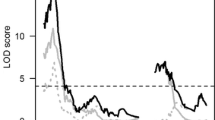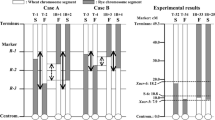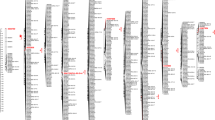Abstract
Key message
Restoration of fertility in the cytoplasmic male sterility-inducing Triticum timopheevii cytoplasm can be achieved with the major restorer locus Rf3 located on chromosome 1B, but is also dependent on modifier loci.
Abstract
Hybrid breeding relies on a hybrid mechanism enabling a cost-efficient hybrid seed production. In wheat and triticale, cytoplasmic male sterility based on the T. timopheevii cytoplasm is commonly used, and the aim of this study was to dissect the genetic architecture underlying fertility restoration. Our study was based on two segregating F2 triticale populations with 313 and 188 individuals that share a common female parent and have two different lines with high fertility restoration ability as male parents. The plants were cloned to enable replicated assessments of their phenotype and fertility restoration was evaluated based on seed set or staining for pollen fertility. The traits showed high heritabilities but their distributions differed between the two populations. In one population, a quarter of the lines were sterile, conforming to a 3:1 segregation ratio. QTL mapping identified two and three QTL in these populations, with the major QTL being detected on chromosome 1B. This QTL was collinear in both populations and likely corresponds to Rf3. We found that Rf3 explained approximately 30 and 50% of the genotypic variance, has a dominant mode of inheritance, and that the female parent lacks this locus, probably due to a 1B.1R translocation. Taken together, Rf3 is a major restorer locus that enables fertility restoration of the T. timopheevii cytoplasm, but additional modifier loci are needed for full restoration of male fertility. Consequently, Rf3 holds great potential for hybrid wheat and triticale breeding, but other loci must also be considered, either through marker-assisted or phenotypic selection.





Similar content being viewed by others
References
Ahmed TA, Tsujimoto H, Sasakuma T (2001) QTL analysis of fertility-restoration against cytoplasmic male sterility in wheat. Genes Genet Syst 76:33–38
Bahl PN, Maan SS (1973) Chromosomal location of fertility restoring genes in six lines of common wheat. Crop Sci 13:317–320
Baierl A, Bogdan M, Frommlet F, Futschik A (2006) On locating multiple interacting quantitative trait loci in intercross designs. Genetics 173:1693–1703
Bernhard T, Friedt W, Snowdon RJ, Wittkop B (2017) New insights into genotypic thermodependency of cytoplasmic male sterility for hybrid barley breeding. Plant Breed. 136:8–17
Boeven PHG, Longin CFH, Würschum T (2016) A unified framework for hybrid breeding and the establishment of heterotic groups in wheat. Theor Appl Genet 129:1231–1245
Chase CD (2007) Cytoplasmic male sterility: a window to the world of plant mitochondrial nuclear interactions. Trends Genet 23:81–90
Chen L, Liu Y-G (2014) Male sterility and fertility restoration in crops. Annu Rev Plant Biol 65:579–606
Churchill GA, Doerge RW (1994) Empirical threshold values for quantitative trait mapping. Genetics 138:963–971
Cui X, Wise RP, Schnable PS (1996) The rf2 nuclear restorer gene of male-sterile T-cytoplasm maize. Science 272:1334–1336
Curtis CA, Lukaszewski AJ (1993) Localization of genes in rye that restore male fertility to hexaploid wheat with timopheevi cytoplasm. Plant Breed 111:106–112
Darvasi A, Soller M (1997) A simple method to calculate resolving power and confidence interval of QTL map location. Behav Genet 27:125–132
Du H, Maan SS, Hammond JJ (1991) Genetic analyses of male fertility restoration in wheat: III. Effects of aneuploidy. Crop Sci 31:319–322
Fukasawa H (1953) Studies on restoration and substitution of nucleus (genome) in Aegilotricum. I. Appearance of male sterile durum in substitution crosses. Cytologia 18:167–175
Fukasawa H (1955) Studies on restoration and substitution of nucleus of Aegiolotricum. II. The interrelationships between ovate cytoplasm and fertility restoring factors. Cytologia 2:211–217
Geyer M, Bund A, Albrecht T, Hartl L, Mohler V (2016) Distribution of the fertility-restoring gene Rf3 in common and spelt wheat determined by an informative SNP marker. Mol Breed 36:167
Gilmour AR, Gogel B, Cullis B, Thompson R (2009) ASReml user guide release 3.0. VSN International Ltd, Hemel Hempstead
Haley CS, Knott SA (1992) A simple regression method for mapping quantitative trait loci in line crosses using flanking markers. Heredity 69:315–324
Hohn CE, Lukaszewski AJ (2016) Engineering the 1BS chromosome arm in wheat to remove the Rf multi locus restoring male fertility in cytoplasms of Aegilops kotschyi, Ae. uniaristata and Ae. mutica. Theor Appl Genet 129:1769–1774
Jansen RC, Stam P (1994) High resolution of quantitative traits into multiple loci via interval mapping. Genetics 136:1447–1455
Johnson JW, Patterson FL (1973) Pollen production of fertility restored lines of soft red winter wheat. Crop Sci 13:92–95
Kempe K, Gils M (2011) Pollination control technologies for hybrid breeding. Mol Breed 27:417–437
Kihara H (1951) Substitution of nucleus and its effects on genome manifestations. Cytologia 16:117–193
Kihara H, Tsunewaki K (1967) Genetic principles applied to the breeding of crop plants. In: Brink RA (ed) Heritage from Mendel. University of Wisconsin Press, Madison, pp 403–418
Kojima T, Tsujimoto H, Ogihara Y (1997) High resolution RFLP mapping of the fertility restoration (Rf3) gene against Triticum timopheevi cytoplasm located on chromosome 1BS of common wheat. Genes Genet Syst 72:353–359
Li H, Vikram P, Singh RP, Kilian A, Carling J et al (2015) A high density GBS map of bread wheat and its application for dissecting complex disease resistance traits. BMC Genom 16:216
Livers RW (1964) Fertility restoration and its inheritance in cytoplasmic male sterile wheat. Science 144:420
Longin CFH, Mühleisen J, Maurer HP, Zhang H, Gowda M, Reif JC (2012) Hybrid breeding in autogamous cereals. Theor Appl Genet 125:1087–1096
Longin CFH, Gowda M, Mühleisen J, Ebmeyer E, Kazman E, Schachschneider R, Schacht J, Kirchhoff M, Zhao Y, Reif JC (2013) Hybrid wheat: Quantitative genetic parameters and consequences for the design of breeding programs. Theor Appl Genet 126:2791–2801
Longin CFH, Reif JC, Würschum T (2014) Long-term perspective of hybrid versus line breeding in wheat based on quantitative genetic theory. Theor Appl Genet 127:1635–1641
Losert D, Maurer HP, Weissmann S, Würschum T (2016) Hybrid breeding for biomass yield in winter triticale: I. Hybrid performance, trait correlations and heterosis. Plant Breed 135:560–566
Ma Z-Q, Sorrells ME (1995) Genetic analysis of fertility restoration in wheat using restriction fragment length ploymorphisms. Crop Sci 35:1137–1143
Maan SS, Lucken KA, Bravo JM (1984) Genetic analyses of male-fertility restoration in wheat. I. Chromosomal location of Rf genes. Crop Sci 24:17–20
Miedaner T, Glass C, Dreyer F, Wilde P, Wortmann H, Geiger HH (2000) Mapping of genes for male-fertility restoration in ´Pampa´ CMS winter rye (Secale cereale L.). Theor Appl Genet 101:1226–1233
Mühleisen J, Piepho H, Maurer HP, Longin CFH, Reif JC (2014) Yield stability of hybrids versus lines in wheat, barley, and triticale. Theor Appl Genet 127:309–316
Mukai Y (1983) Determination of the chromosome arm carrying a male fertility-restoring gene against the cytoplasm of Aegilops uniaristata in wheat. Mem Osaka Kyoiku Univ III 32:43–53
Mukai Y, Tsunewaki K (1979) Basic studies on hybrid wheat breeding. VIII. A new male sterility–fertility restoration system in common wheat utilizing the cytoplasms of Aegilops kotschyi and Ae. variabilis. Theor Appl Genet 54:153–160
Nalepa S (1990) Hybrid triticale: present and future. Proceedings of 2nd International Triticale Symposium, Paso Fundo. 402–407
Oehler E, Ingold M (1966) New cases of male-sterility and new restorer source in T. aestivum. Wheat Inf Serv 22:1–3
Oettler G, Tams SH, Utz HF, Bauer E, Melchinger AE (2005) Prospects for hybrid breeding in winter triticale: I. Heterosis and combining ability for agronomic traits in European germplasm. Crop Sci 45:1476–1482
Schmidt JW, Johnson VA, Maan SS (1962) Hybrid wheat. Nebr Exp Stn Q 9:9
Sinha P, Tomar SMS, Vinod, Singh VK, Balyan HS (2013) Genetic analysis and molecular mapping of a new fertility restorer gene Rf8 for Triticum timopheevi cytoplasm in wheat (Triticum aestivum L.) using SSR markers. Genetica 141:431–441
Stojałowski S, Bobrowska A, Hanek M, Myśków B (2013) The importance of chromosomes from the sixth homeologic group in the restoration of male fertility in winter triticale with Triticum timopheevii cytoplasm. J Appl Genet 54:179–184
Tahir CM, Tsunewaki K (1969) Monosomic analysis of fertility restoring gene in Triticum spelta var duhamelianum. Wheat Inform Serv 28: 5–7
Tsujimoto H, Tsunewaki K (1984) Chromosome location of a fertility-restoring gene of a common wheat Chinese Spring for the Ae. mutica cytoplasm. Wheat Inform Serv 58:4–8
Tsunewaki K (1974) Monosomic analysis of two restorers to Ae. caudate and Ae. umbellulata cytoplasms. Jpn J Genet 49:425–433
Tsunewaki K (2015) Fine mapping of the first multi-fertility-restoring gene, Rfmulti, of wheat for three Aegilops plasmons, using 1BS-1RS recombinant lines. Theor Appl Genet 128:723–732
Utz HF, Melchinger AE (1996) PLABQTL: a program for composite interval mapping of QTL. J Agric Genom 2:1–5
Utz HF, Melchinger AE, Schön CC (2000) Bias and sampling error of the estimated proportion of genotypic variance explained by quantitative trait loci determined from experimental data in maize using cross validation and validation with independent samples. Genetics 154:1839–1849
Van Ooijen JW (2006) JoinMap ® 4, Software for the calculation of genetic linkage maps in experimental populations. Kyazma B.V., Wageningen
Walcott JJ (1985) The effect of the Triticum timopheevi nucleo-cytoplasmic system on the performance of an F1 hybrid wheat. Aust J Agric Res 36:553–557
Wang Z, Zou Y, Li X, Zhang Q, Chen L, Wu H, Su D, Chen Y, Guo J, Luo D, Long Y, Zhong Y, Liu Y-G (2006) Cytoplasmic male sterility of rice with boro II cytoplasm is caused by a cytotoxic peptide and is restored by two related PPR motif genes via distinct modes of mRNA silencing. Plant Cell 18:676–687
Wilson JA (1968) Problems in hybrid wheat breeding. Euphytica 17(Suppl 1):13–33
Wilson JA, Driscoll CJ (1983) Hybrid wheat. In: Frankel R (ed) Heterosis: Monographs on theoretical and applied genetics vol 6 Springer, Berlin Heidelberg pp 94–123
Wilson JA, Ross WM (1962) Male sterility interaction of the Triticum aestivum nucleus and Triticum timopheevi cytoplasm. Wheat Inf Serv 14:14–29
Yen F, Evans LE, Larter EN (1969) Monosomic analysis of fertility restoration in three restorer lines of wheat. Can J Genet Cytol 11:531–546
Zeng ZB (1994) Precision mapping of quantitative trait loci. Genetics 136:1457–1468
Zhou W, Kolb FL, Domier LL, Wang S (2005) SSR markers associated with fertility restoration genes against Triticum timopheevii cytoplasm in Triticum aestivum. Euphytica 141:33–40
Acknowledgements
This research was conducted within the HYENERGY project funded by the German Federal Ministry of Food and Agriculture (Grant FKZ 22015109) and handled by the Fachagentur Nachwachsende Rohstoffe e.V. (FNR). We thank Laura Eyermann, Barbara Renz, and Stefanie Laucher for excellent work in the lab.
Author information
Authors and Affiliations
Corresponding author
Ethics declarations
Conflict of interest
The authors declare that they have no conflict of interest.
Ethical approval
The authors declare that the experiments comply with the current laws of Germany.
Additional information
Communicated by Xianchun Xia.
Electronic supplementary material
Below is the link to the electronic supplementary material.
Rights and permissions
About this article
Cite this article
Würschum, T., Leiser, W.L., Weissmann, S. et al. Genetic architecture of male fertility restoration of Triticum timopheevii cytoplasm and fine-mapping of the major restorer locus Rf3 on chromosome 1B. Theor Appl Genet 130, 1253–1266 (2017). https://doi.org/10.1007/s00122-017-2885-5
Received:
Accepted:
Published:
Issue Date:
DOI: https://doi.org/10.1007/s00122-017-2885-5




